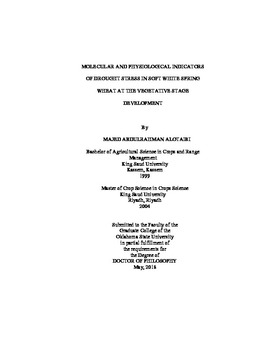| dc.contributor.advisor | Anderson, Michael P. | |
| dc.contributor.author | Alotaibi, Majed Abdulrahman | |
| dc.date.accessioned | 2019-03-25T21:13:44Z | |
| dc.date.available | 2019-03-25T21:13:44Z | |
| dc.date.issued | 2018-05-01 | |
| dc.identifier.uri | https://hdl.handle.net/11244/317734 | |
| dc.description.abstract | Drought stress has negative effects at all wheat stages and can reduce the total yield by 50%. Two greenhouse were executed one for RNA sequencing and the other one was for chlorophyll fluorescence measurements under drought stress. Transcriptomic analyses via RNA sequencing of two soft white spring wheat at vegetative stage development were achieved under three conditions. The treatments involved well-watered (WW, 100%, 236 ml) as control, moderate stressed (MS, 50%, 118 ml) and severe stressed (SS, 25%, 59 ml). The RNA sequencing datasets from Alpowa contained 690,857; 663,526 and 652,705 reads from WW MS and SS, whereas the Idaho datasets were 523,643; 485,527 and 489,436 reads under WW, MS and SS, respectively. Bioinformatics analysis of the sequence data was performed and in general, Idaho showed 3.1 times more of up regulated and 2.7 times more down regulated differentially expressed genes than Alpowa. The top twenty GO terms were performed for biological processes of up and down regulated transcripts that are differentially expressed in response to MS and SS in comparison to the WW condition. The results suggest that transcription/translation and their associated regulation are the most active biological processes for differential gene expression in vegetative tissues from water limited soft white spring wheat plants. Another two greenhouse experiments for photosynthetic measurements (Long Drought Period vs. Acute Drought Period) were executed. A modulated fluorimeter has been used to compare the effects of long term and acute water limitations imposed on two cultivars in order to determine photochemical differences between soft white spring wheat cultivars, among stress intensities and over several sampling dates. Alpowa and Idaho showed significant differences in terms of Y (II) on May 12 only for all stress intensity treatments (WW, MS, SS for Alpowa and WW, SS for Idaho). The data from Y (II) and Y (NO) suggest that the effect observed on May 12th is not associated with stress imposition but may be the result of leaf maturation and pre-metabolic conversion to complete reproductive function. Both Fv/Fm and Y (II) measure the same response. | |
| dc.format | application/pdf | |
| dc.language | en_US | |
| dc.rights | Copyright is held by the author who has granted the Oklahoma State University Library the non-exclusive right to share this material in its institutional repository. Contact Digital Library Services at lib-dls@okstate.edu or 405-744-9161 for the permission policy on the use, reproduction or distribution of this material. | |
| dc.title | Molecular and Physiological Indicators of Drought Stress in Soft White Spring Wheat at the Vegetative Stage Development | |
| dc.contributor.committeeMember | Mort, Andrew | |
| dc.contributor.committeeMember | Kakani, Vijaya Gopal | |
| dc.contributor.committeeMember | Ayoubi Canaan, Patricia Jane | |
| osu.filename | Alotaibi_okstate_0664D_15600.pdf | |
| osu.accesstype | Open Access | |
| dc.description.department | Crop Science | |
| dc.type.genre | Dissertation | |
| dc.type.material | text | |
